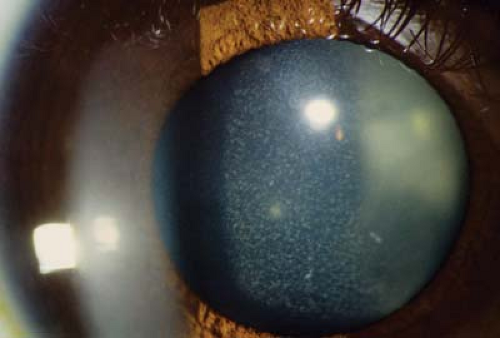Endocrine
Alex V. Levin
Thomas W. Wilson
Robert Pashby
The pituitary gland is responsible for regulating hormonal activity within the body. Abnormalities of the pituitary gland may lead to hormonal disruption with secondary effects in the eye. The close proximity of the pituitary to other midline brain structures and the optic chiasm may lead to combined endocrine and ophthalmic findings. An example is septo-optic dysplasia (De Morsier syndrome). Hormone-secreting tumors can also lead to ophthalmic pathology.
Other organs in the endocrine system include the pancreas, adrenal glands, parathyroid glands, and thyroid gland. Disease in any of these structures may have a remote secondary effect on the eye by a variety of mechanisms. Knowledge of these complications will assist the primary care physician and endocrinologists in making appropriate referrals to the ophthalmologist both for screening and in response to ocular signs and symptoms.
 Figure 16.1 Diabetes Mellitus— Cataract Although retinopathy is common in adults, diabetes rarely has ocular complications in the prepubertal years. This photograph shows multiple cortical opacities, similar to the pulverulent cataract (Chapter 7: Lens, Fig. 7.10). Cataract onset may range from infancy to adolescence, and a wide variety of morphology may be seen also, including posterior subcapsular, lamellar, and total cataract (Chapter 7: Lens). Cataract may present before, at, or after the diagnosis of diabetes. Although visual prognosis following surgery is generally good, there is some evidence to suggest that surgery may hasten the onset or progression of diabetic retinopathy. |
 Figure 16.2 Diabetes Mellitus— Papillopathy
Stay updated, free articles. Join our Telegram channel
Full access? Get Clinical Tree
 Get Clinical Tree app for offline access
Get Clinical Tree app for offline access

|